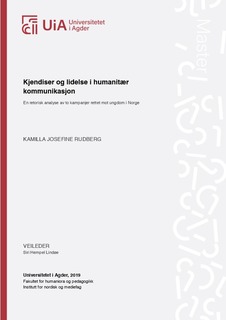| dc.contributor.author | Rudberg, Kamilla Josefine | |
| dc.date.accessioned | 2019-11-11T10:39:34Z | |
| dc.date.available | 2019-11-11T10:39:34Z | |
| dc.date.issued | 2019 | |
| dc.identifier.uri | http://hdl.handle.net/11250/2627658 | |
| dc.description | Masteroppgave samfunnskommunikasjon KOM500 - Universitetet i Agder 2019 | nb_NO |
| dc.description.abstract | Over the past few decades there has been a rapid digital development. This advancement affectshumanitarian organizations, where the development of social media offers new possibilities for communication. This master thesis includes two humanitarian campaigns which is mediated through socialmedia. The target audience of both campaigns are young adults, agroup which has grown up alongside smartphones and digital networks. The first campaign, Marlon’s Journey, seeks to engage Norwegian young adults about young refugees. The campaign is mediated through IGTV as a web series. In the series, the Norwegian actor Marlon Langeland meet refugees in Lebanon, Colombia and DR Congo. The second campaign, Trollmelding, wants to contribute to a healthier climate for debate on the Internet regarding refugees. A rhetorical analysis of the campaigns highlightsthe rhetorical strategies used to influence the young target audience. Strategies that appeal to the audience’s personal identification is prominent in Marlon’s Journey. In the campaign, Marlon is presented as the narrator and main character, identifying himself physically and emotionally with the encountered refugees. He shares his feelings and thoughts with the audience as if they were his close friends, potentially affecting the way the audience perceive the theme presented in the campaign. Trollmeldinguse strategies compelling the audience to reflect about the presented issue. To put the audience in this position, illusion and contrast are among the strategies applied between different elements of the campaign. While the audience is drawn ‘into’ the universe in Marlon’s Journeythrough identification strategies, they are challenged to be placed on the ‘outside’ of the campaign Trollmeldingthrough reflectionstrategies.This study includes the ethical challenges following the use of these rhetorical strategies.The ethical perspective points toward the belief that suffering is not the main focus in neither of the campaigns. Firstly, the audience is not granted the possibility to prevent the suffering they witness. Secondly, what appeals mostly to the audience’s emotions are celebrities and the phenomenon of ‘cyber hate’, and not the suffering people in the campaigns. This reflect a view about humanitarian communication as a changing field. Thischange is the reason why it is relevant to maintain the ongoing discussion about humanitarian communication. I hope this study will be an inspiration to keep thediscussion alive. | nb_NO |
| dc.language.iso | nob | nb_NO |
| dc.publisher | Universitetet i Agder ; University of Agder | nb_NO |
| dc.rights | Attribution-NonCommercial-NoDerivatives 4.0 Internasjonal | * |
| dc.rights.uri | http://creativecommons.org/licenses/by-nc-nd/4.0/deed.no | * |
| dc.subject | KOM500 | nb_NO |
| dc.title | Kjendiser og lidelse i humanitær kommunikasjon : En retorisk analyse av to kampanjer rettet mot ungdom i Norge | nb_NO |
| dc.type | Master thesis | nb_NO |
| dc.subject.nsi | VDP::Samfunnsvitenskap: 200::Medievitenskap og journalistikk: 310 | nb_NO |
| dc.source.pagenumber | 88 s. | nb_NO |

